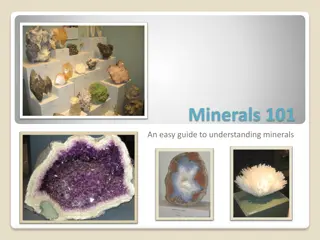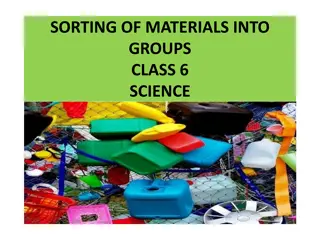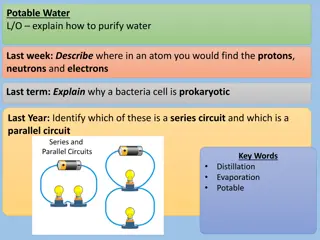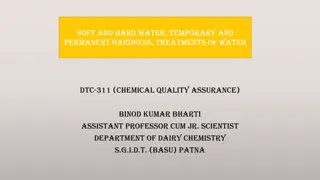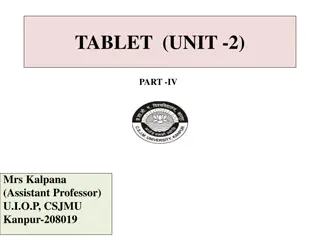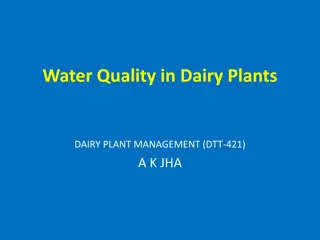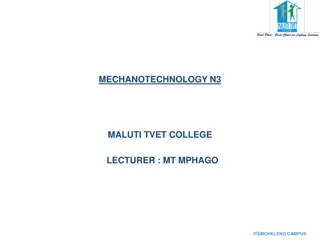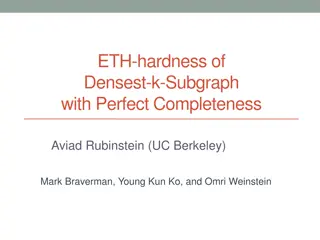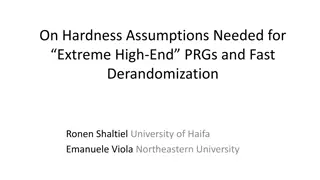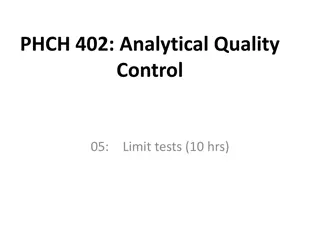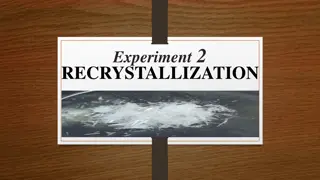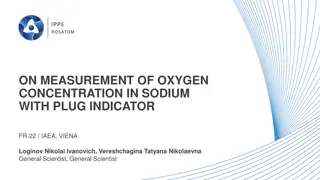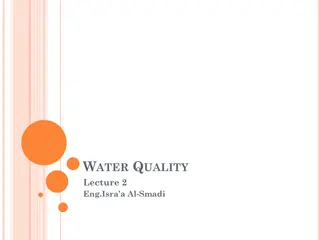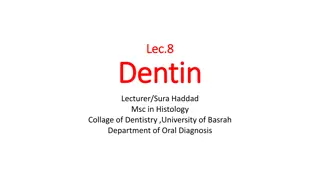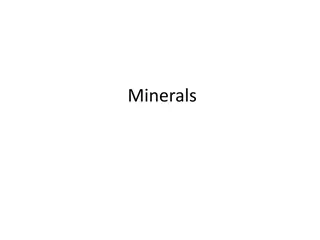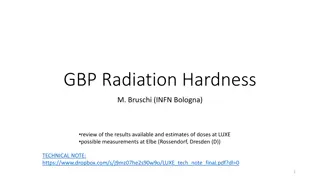Understanding Water Hardness and Impurities in Water Technology
Water technology in the field of Engineering Chemistry explores sources of water, major impurities, hardness of water, and distinctions between hard and soft water. The content delves into the impact of mineral concentrations on soap lathering, categorizes hardness into temporary and permanent forms, and highlights the characteristics of different water sources. It also discusses the effects of dissolved substances like calcium, magnesium, and heavy metals on water quality.
Download Presentation

Please find below an Image/Link to download the presentation.
The content on the website is provided AS IS for your information and personal use only. It may not be sold, licensed, or shared on other websites without obtaining consent from the author. Download presentation by click this link. If you encounter any issues during the download, it is possible that the publisher has removed the file from their server.
E N D
Presentation Transcript
WATER TECHNOLOGY Course: B.Tech Subject: Engineering Chemistry Unit:4 1
Sources of Water A) SurfaceWaters Rain Water - Pure but contaminated with gases River Water - High dissolved salts moderate organics Lake Water - Const. composition but high organics Sea Water - High salinity, pathogens, organics B) UndergroundWaters Spring/Well Water - Crystal clear but high dissolved salts and high purity from organics 2
MAJOR IMPURITIES OF WATER Ionic anddissolved Cationic Calcium Magnesium Anionic Bicarbonate Carbonate Hydroxide Nonionic and undissolved Turbidity, silt, mud, dirt and other suspendedmatter Gases CO2 H2S NH3 CH4 O2 Alkalinity Sodium Potassium Ammonium Iron Manganese Color,Plankton Organicmatter, Sulfate ChlorideColloidal silica, Nitrate Phosphate Microorganisms, Bacteria 3
HARD WATER Hardness refers to the presence of calcium and magnesium ions in water (and sometimes iron). Ions come from dissolved rock the water has passed through. Affects properties of tap water 1
HARD WATER Minerals in hard water interact with soap. Interferes with soap s ability to lather. 2
SOFTWATER Water with very low concentrations of minerals. Soap lathers easily and is sometimes difficult to rinse off. 3
HARDNESS OF WATER Hardness in Water is characteristic that prevents the lathering of soap thus water which does not produce lather with soap solution readily, but forms a white curd is called hard water. Type of Hardness Temporary or Carbonate Hardness Permanent Hardness or non-carbonate Hardness. 7
Temporary Hardness Temporary Hardness is caused by the presence of dissolved bicarbonateof calcium, magnesium and other heavy metals and the carbonate of iron. It is mostly destroyed by more boiling of water, when bicarbonates are decomposed yielding insoluble carbonates. Ca(HCO3)2 Calcium bicarbonate Heat CaCO3 + H2O + CO2 Calcium Carbonate Mg(HCO3)2 Magnesium Bicarbonate Heat Mg(OH)2 + 2CO2 Magnesium hydroxide Calcium/Magnesium Carbonates thus formed being almost insoluble, are deposited as a scale at the bottom of vessel, while carbon dioxide escapes out. 8
PERMANENT HARDNESS Non Carbonate Hardness is due to the presence of chlorides, sulfatesof calcium, Magnesium, iron and other heavymetals (C17H35COO)2Ca + 2NaCl Calcium stearate 2C17H35COONa + CaCl2 Sodiumstearate Hardness (sodium soap) (Insoluble) 2C17H35COONa + MgSO4 (C17H35COO)2Mg + 2Na2SO4 Magnesium stearate Sodiumstearate Hardness (Insoluble) (sodium soap) 9
Draw backs (or) Disadvantages of Hard Water Domestic Use Industrial Use 1. Washing 1. Textile Industry 2. Sugar Industry 2. Bathing 3. Dyeing Industry 3. Drinking 4. Paper Industry 4. Cooking 5. Pharmaceutical Industry The fabric/cloth and gives spots and streaks. Fe salts stain the cloths. sticky precipitate adheres on the 6. In Steam generation in Boilers Produces sticky scum on the bath tub and the body Bad to the digestive system and calcium oxalate formation is possible in urinary tracts Requires more fuel and time. Certains food don t cook soft and also gives unpleasant taste 10
Boiler troubles due to Hard Water 1. Sludge 1. Scale and Sludge Slimy loose precipitatecalled sludge suspended inwater 2. Caustic embitterment 3. Priming and Foaming water 4. Boiler corrosion 4 Boilerwall Sludge is a soft, loose and slimy precipitate formed within the boiler. It can be easily scrapped off with a wire brush. It is formed at comparatively colder portions of the boiler and collects in areas of the system, where the flow rate is slow or at bends. It is formed by substances which have greater solubility's in hot water than in cold water, e.g. MgCO3, MgCl2, CaCl2, MgSO4etc., 11 Remedy: Sludges can be removed using wire brush or mild acid
DISADVANTAGE OF SLUDGE FORMATION: -poor conductor of heat -disturbs the working ofboiler. - If along with scales : both get deposited asscales. Preventation of Sludge formation: - Well softened water - Drawing off a portion of concentratedwater. 12
1. Scale Hard adherent coating on inner walls of boiler water Boiler wall 6 5 Scales are hard substances which sticks very firmly to theinner surfaces of the boiler wall. Scales are difficult to remove even with the help of a hammer and chisel. 13 Examples: CaSO4, CaCO3, Mg(OH)2
Reasons for formation of scale 1. Presence of Ca(HCO3)2 in low pressureboilers Low pressure boilers but in high pressure boilers it is soluble by forming Ca(OH)2 Ca(HCO3)2 Calcium bicarbonate CaCO3 + H2O + CO2 Calcium Carbonate (scale) 2. Presence of CaSO4 in high pressureboilers ToC Solubility of CaSO4 4. Presence of SiO2 15 3200 ppm 230 15ppm It forms insoluble hard adherent CaSiO3 and MgSiO3 asscales 320 27ppm Cold water soluble Super heated water Insoluble (scale) 3. Presence of MgCl2 in high temperatureboilers MgCl2 + 2H2O Magnesium chloride Mg (OH)2 + 2HCl scale Mg(OH)2 can also be generated by thermally decomposing Mg(HCO3)2 14
Disadvantages of scale formation 1. Fuel wastage scales have low thermal conductivity 2. Degradation of boiler material and increases of risk of accident 3. Reduces the efficiency of the boiler and- deposit on the valves andcondensers 4. The boiler may explode if crack occurs in scale Remedies: Removal of scale 1. Using scrapper, wire brush often 2. By thermal shock- heating and cooling suddenly with cold water 3. Using chemicals 5-10% HCl and by adding EDTA 15
Prevention of scale formation Scale formation can be prevented by two methods 1. Internal conditioning or InternalTreatment 2. External conditioning or External treatment- will be discussedlater 1. Internal conditioning methods - of boiler water to prevent scaleformation 1. Phosphate conditioning addition of phosphate compound 2. Carbonate conditioning addition of carbonate compound 3. Calgon conditioning addition of sodium hexa meta phosphate 4. Colloidal conditioning spreading of organic compounds like tannin, agar gel 5. Sodium Aluminate removes oil and silica 6. Electrical Conditioning 7. Radioactive Conditioning 16 8. Complexometric method using EDTA
1. Phosphate conditioning Scale formation can be prevented by adding sodium phosphate to the boiler water which reacts with the hardness producing ions and forms easily removable phosphate salts of respectiveions 3CaCl2 (Boiler water) + 2 Na3PO4 Ca3(PO4)2 + 6NaCl 17
Selection of Phosphate compound Calcium can not be precipitated below a pH = 9.5, hence the selectionof phosphate has to be based on the pH of the boiler feedwater. NaH2PO4 (acidic in nature), Na2HPO4 (weakly alkaline in nature), Na3PO4(Alkaline in nature) 2. Carbonate conditioning CaSO4 (Boiler water) + Na2CO3 CaCO3+ Na2SO4 Caution: Excess Na2CO3 can result in causticembrittlement 18
3. Calgon conditioning Na2[Na4(PO3)6 2Na+ + [Na4P6O18]2- Calgon sodium hexa meta phosphate [Ca2P6O18]2- +2Na2SO4 2CaSO4 (Boiler water) + [Na4P6O18]2- Calcium sulfate Soluble complexion of calcium - can be removed easily Calgon tablets are used in the cleaning of washing machinedrums 19
4.Colloidal conditioning: In low pressure boilers- scale : adding org. substances like kerosine, agar-agar, tannin,etc. - Yield non-sticky & loose deposits 5. Treatment withNaAlO2: NaAlO2 +2H2O MgCl2 +2NaOH NaOH + Al(OH)3(gelatinousppt) Mg(OH)2 +2NaCl 20
6.Electrical conditioning: Sealed glass bulbs-mercury: battery Water boils- mercury bulb - emit electrical discharged 7. Radioactive conditioning: Tablets - radioactive salts 8. Complexometric method: - 1.5% alk. Soln of EDTA - EDTA : cation & form stable & solublecomplex. 21
Other treatment: Prevent : iron oxide Protects boiler unit from corrosion by wetsteam. Reduces the carry over of oxides with steam 1. 2. 3. 22
CAUSTIC EMBRITTLEMENT: Is a type of boilercorrosion. Caused : highly alkalineWater. Na2CO3 + H2O 2 NaOH +CO2 Boiler water becomes caustic Water evaporates caustic soda concentrationincrease. which attacks surrounding area of boilermachine. Iron converted in to sodiumferroate. Causes embrittlement of boiler parts, strssed parts( bends, joints,etc.) Iron : in dilute NaOH cathodicside Iron : in concentrated NaOH anodicside. 23
Preventation of caustic Embrittlements: Sodium phosphate sodiumcarbonates Adding lignin : preventing infilteration of caustic sodasolution Sodium sulphate: Na2SO4concentration NaOH concentration Kept 1:1, 2:1 & 3:1, Pressure : 10,20 & above20. 24
IV. Boiler corrosion Degradation or destruction of boiler materials (Fe) due to the chemical or electrochemical attack of dissolved gases or salts is called boilercorrosion Boiler corrosion is of threetypes 1. Corrosion due to dissolvedO2 2. Corrosion due to dissolvedCO2 3. Corrosion due to acids formed by dissolvedsalts 1. Corrosion due to dissolved oxygen(DO) 2 Fe + 2 H2O +O2 2 Fe(OH)2 4 Fe(OH)2 + O Ferrous hydroxide 2 [Fe2O3.2H2O] 2 Rust
Removal of Dissolved Oxygen (DO) 1. By the addition of chemicals The dissolved oxygen present in the boiler feed water can be removed bythe addition of sodium sulphite or hydrazine and the reactions can be writtenas below 2 Na2SO3 + O2 2 Na2SO4 Sodium sulphite Na2S + 2O2 Na2SO4 Sodium sulphate DO N2+ 2H2O N2H4 +O2 Nitrogen Hydrazine
2. Corrosion due to dissolvedCO2 Presence of bicarbonate salts of either magnesium or calcium also causes therelease of CO2 inside the boiler apart from the dissolvedCO2 Mg(HCO3)2 MgCO3 + H2O +CO2 CO2+ H2O H2CO3 (causes slowcorrosion) 3. Corrosion due to dissolvedsalts MgCl2 + 2 H2O Mg(OH)2 + 2HCl Fe + 2 HCl FeCl2+ H2 FeCl2+ 2 H2O Fe(OH)2 + 2HCl
Prevention : (1) Corrosion can be prevented by adding alkali to neutralizeacidity & anti-oxidant to remove oxygen (2) By keeping pH value 8 to 9. (3) Oxygen is removed from boiler feed-water by addingNa2SO3. (4) Oxygen can also removed by treating it with hydrazinehydrate NH2 NH2 NH2-NH2 + O2 2N2 + 2H2O 28
III. Priming and foaming Foaming It is the production of continuous foam or hard bubblers in boilers. Foaming is due to the presence of substance like oil in boiling water. Priming Foaming Normalbubble It is the process in which some particles in water are carried along with the steam. process is called as wet steam or carry over. The process of formation of wet steam in boilers is called as priming. The resulting Priming Carry overbubble 7
Causes of Priming (1) the presence of large amount of dissolvedsolids (2) high steamvelocities. (3) sudden boiling (4) improper boiler design (5) sudden increase in steam-productionrate. Disadvantages of Priming (1) Dissolved salt in boiler water are carried out by the wet steam toturbine blades - which reduces theirefficiency. (2) Dissolved salts may enter the parts of other machinery may decreasethe life of the machinery. (3) Actual height of the water column cannot be judge properly,Thereby making the maintenance of the boiler pressure becomesdifficult. 30
Prevention of Priming (1) By improving boiler design. (2) By fitting mechanical steam purifiers. (3) By maintaining low water level in boilers (4) By using soft water. (5) By decreasing the amount of dissolved salts. ( B) FOAMING : It is the production of foam or bubbles in boiler which do not break easily. Causes of Foaming : It is due to the presence of oily substances in water. (1) Low level of water in boiler. (2) The presence of dissolved salts in water. (3) Sudden increase in steam production rate. 31
Disadvantages of foaming: (1) Actual height of the water column cannot bejudge. (2) Dissolved salts in water carried by the wet steam maydamage turbine blads or machineryparts. (3) Boiler pressure cannot bemaintained. Prevention of Foaming : (1) By the addition of anti-foaming chemicals like castor oil,Gallic acid, tennic acid etc. (2) removing oil from boiler water by adding compoundslike sodium aluminate. 32
II . Softening of water/ External treatment of water External Conditioning of water Softening of hard water can be done by the following methods 1. Lime soda process 2. Zeolite methods 3. Ion exchange resin method 4. Mixed bed deionizermethod 1. Lime soda process It is a process in which Lime (Ca(OH)2) and soda (Na2CO3) are added to the hard water to convert the soluble calcium and magnesium salts to insoluble compounds by a chemical reaction. The CaCO3and Mg(OH)2so precipitated are filtered off and removedeasily. It is further divided in to twotypes 1. Cold lime soda process 2. Hot lime soda process
1. Cold lime soda process Step 1 In this process a calculated quantity of Ca(OH)2(lime) and Na2CO3(soda) are mixed with water at room temperature and added to the hard water. The following reactions takes place depending on the nature ofhardness Chemical reactions If it is permanent hardness and due to calciumsalt Ca2++ Na2CO3 CaCO3 + 2Na+(soda) slimy suspended precipitate If it is due to Magnesiumsalt Mg2++ Ca(OH)2 Mg(OH)2 + Ca2+(lime) slimy suspended precipitate Ca2++ Na2CO3 CaCO3 + 2Na+(soda) slimy suspended precipitate
Chemical reactions contd.. If it is Temporary hardness and due to calciumsalt Ca(HCO3)2+ Ca(OH)2 2CaCO3 + 2H2O slimy suspended precipitate If it is due to Magnesiumsalt Mg(HCO3)2 +2Ca(OH)2 2CaCO3 + Mg(OH)2 +2H2O slimy suspended precipitates Step 2 The precipitates CaCO3and Mg(OH)2are very fine and forms sludge like precipitates in the boiler water and are difficult to remove because it does not settle easily making it difficult to filter and the removal process. Finally reduces the efficiency of theboiler. Therefore, it is essential to add small amount of coagulant (such as Alum, Aluminium sulfate, sodium aluminate etc) which hydrolyses to flocculent precipitate ofAl(OH)3which entraps the fineprecipitates. 35
36 8
When coagulants are added flocculation takes place followed by the formationof flocculants. Flocculent- Gelatinous precipitate which entraps the fine precipitates of CaCO3 and Mg(OH)2 NaAlO2 + 2H2O NaOH +Al(OH)3 Coagulant Al2(SO4)3 + 3 Ca(HCO3)2 Hard water sample 2Al(OH)3 + CaSO4 +CO2 Aluminium sulfate Flocculent- Gelatinous precipitate which entraps the fine precipitates of CaCO3 and Mg(OH)2 The Al(OH)3formed by the addition of coagulants initiates the process of flocculation and entraps the fine precipitates and becomes heavy. The heavier flocs then settles at the bottom and filtered off easily.
Method : Raw water & calculated quantities of chemicals: from the top in to the inner vertical circular chamber. There is a vigorous stirring & continuous mixing : softening of water take place. Softened water comes into the outer co-axial chamber, it rises upwards. Heavy sludge settles down & softened water reaches up. Softened water : passes through a filtering media to ensure complete removal of sludge. Filtered soft water finally flows out continuously through the outlet at the top. Sludge settling at the bottom of the outer chamber is drawn off occasionally. 38
(ii) Hot lime-sodaprocess: Treating water with softening chemicals at a temp. of 80 to150 c. Process : operated close to the boilingpoint. consists three parts: (a)reaction tank: in which raw water, chemicals & steam aremixed, (b)Conical sedimentation vessel : sludge settlesdown. (c)Sand filter : complete removal of sludge from softenedwater. 39
40 9
Advantages of hot lime-soda process: The precipitation reaction is almost complete, Reaction takes place faster, Sludge settles down rapidly; No coagulant is needed, Dissolved gases (which may cause corrosion) are removed, Viscosity of soft water is lower, hence filtered easily, Residual hardness is low compared to cold lime-soda process. 41
Advantages of Lime soda process: 1.Economical 2.Process increses pH value of the treated water, thereby corrosion of the distribution pipes is reduced. 3.Mineral content of water is reduced 4.pH of water raises thus reducing content of pathogenic bacteria 5. iron & Mn: removed. Disadvantages of Lime soda process: 1.Huge amount of sludge is formed and its disposal is difficult 2.Due to residual hardness, water is not suitable for high pressure boilers 42
2. ZEOLITE OR PERMUTIT PROCESS: Zeolite - hydrated sodium alumino silicate, capable of exchanging reversibly its sodium ions for hardness- producing ions in water. The general chemical structure of Zeolite: Na2O.Al2O3.xSiO2.yH2O (x = 2-10 and y = 2-6) Micro pores of Zeolite 43 10 Porous structure of Zeolite
Twotypes: (i) Natural Zeolite: non-porous. e.g., Natrolite (ii) Synthetic zeolite: porous & possess gel structure. They are prepared by heating together china clay, feldspar and soda ash. Zeolites possess higher exchange capacity per unit weight than natural zeolite. 44
Process: Hard water is percolated at a specified rate through a bed of zeolite, kept in a cylinder. The hardness-causing ions are retained by the zeolite as CaZeand MgZe; while the outgoing water contains sodium salts. To remove temporary hardness Na2Ze + Ca(HCO3)2 Na2Ze + Mg(HCO3)2 CaZe + 2NaHCO3 MgZe + 2NaHCO3 To remove permanent hardness Na2Ze + CaCl2 Na2Ze + MgCl2 CaZe + 2NaCl MgZe + 2NaCl 45
REGENERATION OF ZEOLITE: At this stage, the supply of hard water is stopped and exhausted zeolite is reclaimed by treating the bed with concentrated NaCl solution. CaZe or MgZe (exhausted zeolite) + 2NaCl (Brine) Na2Ze + CaCl2 (Reclaimed zeolite) (washings) 47
LIMITATIONS OF ZEOLITE PROCESS: 1. If the water is turbid ---- then the turbidity causing particles clogs the pores of the Zeolite and making it inactive 2. The ions such as Mn2+ and Fe2+ forms stable complex Zeolite which can not be regenerated that easily as both metal ions bind strongly and irreversibly to the zeolite structure. 3. Any acid present in water (acidic water) should be neutralized with soda before admitting the water to the plant, since acid will hydrolyze SiO2 forming silicicacid 48
ADVANTAGES: Residual hardness of water is about 10 ppmonly Equipment is small and easy to handle Time required for softening of water issmall No sludge formation and the process isclean Zeolite can be regenerated easily using brinesolution Any type of hardness can be removed without any modifications to the process. DISADVANTAGES : 1. Soft water contains more sodium salts than in lime soda process 2. It replaces only Ca2+ and Mg2+ with Na+ but leaves all the other ions like HCO -and CO 2-in the softened water (then it may form NaHCO and Na CO which releasesCO2 3 when the water is boiled and causes corrosion) 3 3 2 3 3. It also causes caustic embitterment when sodium carbonate hydrolyses to give NaOH 49
ION EXCHANGE PROCESS: Ion exchange resins are insoluble, cross linked, long chain organic polymers with a microporous structure, and the functional groups attached to the chain is responsible for the ion-exchange properties. Acidic functional groups (-COOH, -SO3H, etc.) exchange H+ with other cations. Basic functional groups (-NH2=NH etc.) exchange OH- with other anions. 50























